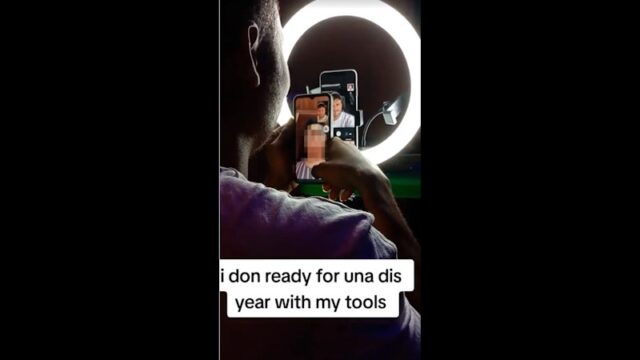
The compliments start flowing as soon as she answers the video call. “Wow, you’re so pretty, honey,” says the man on the other side of the screen. His video feed shows he’s white, with short hair, likely a few years younger than her, and is sitting in front of his camera wearing a plaid shirt.
“You’re looking different with that beard and stuff gone,” the woman says in an American accent as the conversation gets going. The man doesn’t miss a beat. “I told you I was going to shave my beard so I will look good.”
Except, he isn’t who he claims to be. His videofeed is a lie. And—beard or not—the face the woman can see over the video call is not his: It’s a deepfake.
In reality, the man is a scammer using face-swapping technology to totally change his appearance in real-time. In a video of the call—filmed by the scammer’s accomplice likely thousands of miles away from the woman—his real face can be seen on this laptop alongside the fake persona as he speaks to his victim.
This self-shot video is one of scores posted online by scammers known as Yahoo Boys, a loose collective of con artists, often based in Nigeria. The video reveals how they are using deepfakes and face-swapping to ensnare victims in romance scams, building trust with victims using fake identities, before tricking them into parting with thousands of dollars. More than $650 million was lost to romance fraud last year, the FBI says.
The Yahoo Boys have been experimenting with deepfake video clips for around two years and shifted to more real-time deepfake video calls over the last year, says David Maimon, a professor at Georgia State University and the head of fraud insights at identity verification firm SentiLink. Maimon has monitored the Yahoo Boys on Telegram for more than four years and shared dozens of videos with WIRED revealing how the scammers are using deepfakes.
A WIRED review of the videos and three associated Yahoo Boy Telegram channels shows how the con artists’ techniques have evolved as deepfake applications and artificial intelligence have improved. It is one of the first times the specific tactics and outlandish techniques of scammers using deepfake video calls have been documented in this detail.
The videos (View here) show Yahoo Boys using the technology on setups involving both laptops and phones. In multiple videos, the scammers often brazenly show their own faces, as well as those of the victims they are scamming. “I don’t think they’re doing this because they’re stupid,” Maimon says. “I think that they simply don’t care, and they’re not afraid of the repercussions.”












